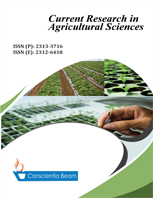Study on Adaptability of Released Midland Maize Varieties around South Ari Woreda, South Omo Zone, Southern Nation Nationality Peoples Region, Ethiopia
Abstract
Ten released maize varieties were tasted at two sites in randomized complete block design with three replication during 2013 cropping season. The experiment was carried out to test the adaptability of improved mid-altitude maize varieties and identify and select the best high yielding variety/ies for the target area. ANOVA revealed significant differences (p<0.05 and 0.01) between varieties for grain yield at both sites and six characters studied (biomass, plant height, ear length, tassel length and northern corn leaf blight). The significance of varieties difference indicates the presence of variability for each of the characters among the tested entries. The mean grain yield at both sites ranged from 71.7 qt/ha for BH545 to 108.71qt/ha for BH670. Shapi (84.38qt/ha) site was low yielding location than Gumter site (92.31qt/ha). Varieties BH660, BH540, BH140, Gibe -2 and BH670 had high mean grain yield and had good mean performance for yield related traits (biomass, ear length and tassel size), except BH540 that sowed high susceptible to northern corn leaf blight. Variety Gibe-2 is open pollinated; possible for farmers to recycle seed up to five year and also it had relatively high mean grain yield, moderate tolerant to northern corn leaf blight and it was the shortest one. Therefore; Gibe -2 would be highly recommended to growing farmers in the studied area and its vicinity, next the two hybrids; BH540 and BH140 would be recommended from yield point of view with great care of disease especially northern corn leaf blight. Further study should be carried out with disease management and improved varieties to improve maize production with increased yield and biomass production.

